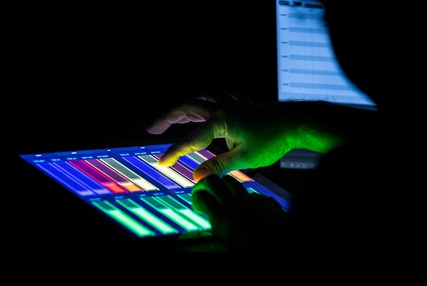Chercheur en acoustique et en traitement du signal à l’Ircam au sein de l’UMR STMS, Markus Noisternig contribue activement, depuis près de 15 ans, aux développements de technologies d’enregistrement et de diffusion du son 3D tels que l’Ambisonic d’ordre supérieur. Ses travaux de recherche doublés d’une solide expérience en musique électronique et dans les arts sonores immersifs et interactifs le conduisent à mener de nombreuses collaborations artistiques.
Nommé en 2019 responsable des interactions entre la recherche et la création à l’Ircam, il nous livre ici sa vision d’un des principes fondateurs de l’Institut : la cohabitation quasi symbiotique entre les scientifiques et les artistes, et la manière de la rendre plus fructueuse encore.
Comment définiriez-vous la « recherche artistique » ? Quels en sont les enjeux généraux et pour quels débouchés ?
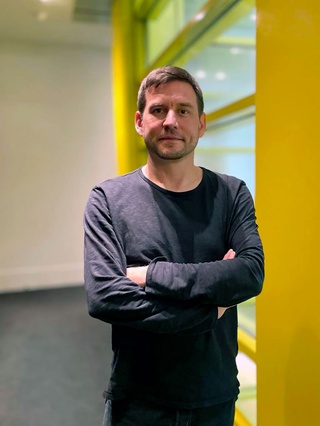 Je ne me lancerais pas dans une définition de la recherche artistique en général, qui recouvre des domaines multiples. Je préfère me concentrer sur une définition de ce qu’est la recherche artistique à l’Ircam – c’est-à-dire une recherche qui tourne autour du son et des phénomènes acoustiques, et de tout ce qu’engage aujourd’hui la composition musicale, depuis la conception jusqu’à la création. Pour moi, qui ai une formation scientifique et artistique, la recherche artistique propose des chemins alternatifs aux méthodes scientifiques.
Je ne me lancerais pas dans une définition de la recherche artistique en général, qui recouvre des domaines multiples. Je préfère me concentrer sur une définition de ce qu’est la recherche artistique à l’Ircam – c’est-à-dire une recherche qui tourne autour du son et des phénomènes acoustiques, et de tout ce qu’engage aujourd’hui la composition musicale, depuis la conception jusqu’à la création. Pour moi, qui ai une formation scientifique et artistique, la recherche artistique propose des chemins alternatifs aux méthodes scientifiques.
Les critères d’évaluation de la démarche scientifique sont très stricts : reproductibilité des expériences, publications, etc. En introduisant la dimension créatrice dans le processus, la recherche artistique ouvre le champ expérimental, qui relève d’une part de la production artistique, et de l’autre, d’avancées scientifiques originales, en termes aussi bien théoriques que méthodologiques ou d’applications.
Comment et quand le concept de résidences artistiques à l’Ircam est-il né ?
Le concept fait partie intégrante du projet initial de l’Ircam. L’idée était, dès le départ, d’inviter aussi bien des artistes que des chercheurs pour développer leurs idées dans un cadre commun.
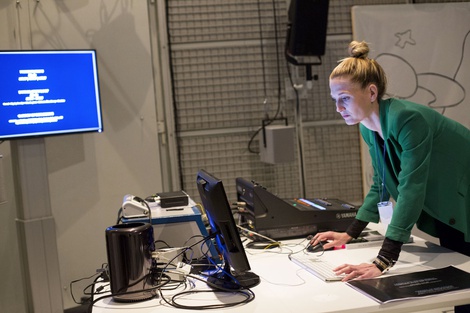
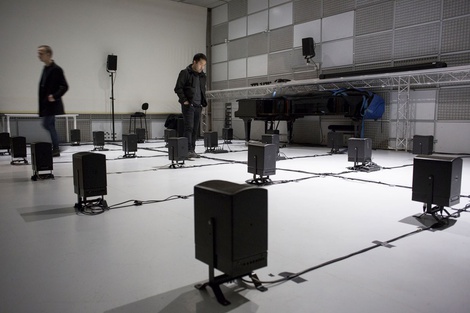
Photo 1 : Nadine Schütz, Conception sonore de terres urbaines - composer dans (l'intérieur de) l'existant
Photo 2 : Brynjar Franzson Davíd, Résidence : Une archive urbaine comme un jardin anglais - Environnement acoustique dans le temps et dans l’espace.
Pourriez-vous citer certaines innovations qui, sans cette recherche artistique à l’Ircam, n’auraient sans doute pas vu le jour ?
Je ne suis pas certain que des innovations n’auraient pas vu le jour : la plupart des outils préexistent aux demandes des artistes, mais les besoins et les souhaits de ceux-ci n’en ont pas moins une influence déterminante pour les adapter, les affiner ou les interroger.
Par exemple, les logiciels d’improvisation, comme Omax et ceux qui ont suivi, ont été fortement influencés par l’artistique, puisqu’ils ont été évalués par des artistes, dont les demandes spécifiques ont été prises en compte.
L’idée artistique permet aussi de développer de nouvelles méthodes. Dans le domaine que je connais le mieux, c’est-à-dire la spatialisation, je me souviens ainsi de mon premier projet avec Olga Neuwirth, qui voulait un « nuage de sons » fluctuant dans l’espace.
Nous avions déjà de nombreux outils de spatialisations sonores, mais sa demande a été un moteur pour développer de nouveaux algorithmes adaptés à ses besoins. De même, la collaboration de notre équipe avec Natasha Barrett en 2012 nous a permis de mettre au point nos encodeurs/décodeurs pour le dôme Ambisonics. Avec Olga Neuwirth encore, pour Le Encantadas o le avventure nel mare delle meraviglie (2015), la captation de l’empreinte acoustique d’une église vénitienne est le résultat d’une recherche au long cours, qui était alors suffisamment mûre pour avoir un débouché artistique et scientifique, lequel a servi ensuite à d’autres très beaux projets.
Vous avez, en 2019, pris la suite de Greg Beller comme responsable des interfaces Recherche/Création à l’Ircam : quel état des lieux avez-vous fait ?
Le principal challenge qui se pose aujourd’hui, c’est de concilier les échelles temporelles des processus artistiques et scientifiques. En effet, le planning d’une production artistique, avec une date de création fixée en amont, ne permet pas nécessairement de faire aboutir les recherches scientifiques. De même, les appels à résidence étaient jusqu’ici des appels génériques, que l’on lançait une fois l’an, et la résidence se terminait parfois avant que les équipes ne soient parvenues à des résultats satisfaisants.
Quels changements avez-vous impulsés à cet égard ?
Dès mon arrivée, j’ai souhaité rapprocher davantage les résidences artistiques des équipes scientifiques, ne serait-ce que dans l’espace, en les faisant partager des bureaux, afin de susciter de véritables collaborations.D’autre part, du point de vue organisationnel, les activités de recherche artistique étaient jusqu’ici indépendantes des départements de la recherche comme de la création. Toujours dans l’idée de rapprocher recherches musicale et scientifique, nous avons décidé de les intégrer au sein de l’UMR STMS.
Avec un pied dans l’artistique et le scientifique (je poursuis mes recherches dans le domaine de l’espace acoustique), j’essaie d’évaluer les besoins de chacun pour les mettre en relation, et j’anime les interactions, tout en coordonnant les résidences et les projets de recherche musicale et en veillant au partage des savoirs entre les différents départements (y compris la Pédagogie).
C’est une collaboration transversale entre départements, équipes et partenaires externes, à l’international notamment. Les interactions et le partage de savoir entre tous les acteurs est essentiel.
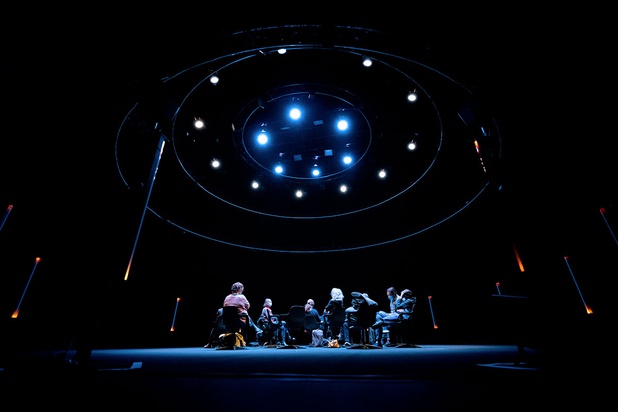 Ircam - T2G - Dôme Ambisonique @ Ircam-Centre Pompidou, photo de Quentin Chevrier
Ircam - T2G - Dôme Ambisonique @ Ircam-Centre Pompidou, photo de Quentin Chevrier
Parlons des nouvelles modalités des résidences artistiques…
À l’Ircam, les résidences sont de deux types : d’un côté, celles qui découlent d’une commande ou d’une invitation de la direction artistique et, de l’autre, celles qui font suite à des appels à candidatures. C’est surtout sur ces dernières que j’ai souhaité revoir notre manière de fonctionner. Le principe général ne change pas : le moteur de ces projets est un problème artistique, qui implique la musique ou, plus généralement, l’audio (musique, théâtre, cinéma, architecture).
Cependant, ces appels à projet sont désormais thématiques. Suite à des échanges réguliers entre direction artistique, UMR, production et réalisateurs en informatique musicale, nous essayons de dégager les pistes les plus porteuses, les champs de recherche qui sont suffisamment mûrs pour que les interactions entre artistes et chercheurs portent leurs fruits. Ce sont des thèmes (par exemple, l’apprentissage profond qui est très à la mode), absolument pas des outils ou des applications prédéterminées – il ne s’agit pas du tout de fermer l’horizon de recherche, mais de cibler certains domaines. Chaque équipe a ses propres besoins de collaboration artistiques.
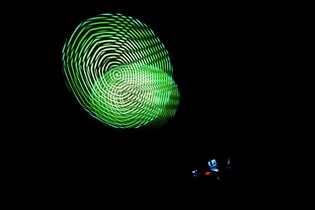
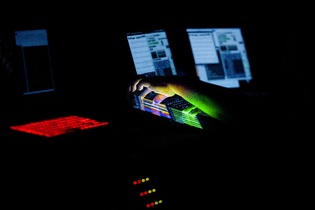
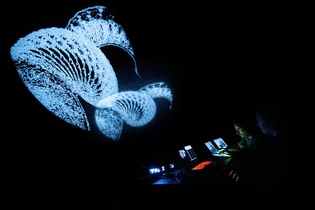
Las Pintas de José Manuel Fernandez dans le cadre du concert Ircam Live au Centre Pompidou © Ircam-Centre Pompidou, photo de Quentin Chevrier
Les réalisateurs en informatique musicale (RIM) sont sur ces sujets des acteurs essentiels : ce sont eux qui travaillent avec les compositeurs et aident à développer les outils spécifiques nécessaires. De plus, leur rôle au sein des équipes de recherche et de production n’est pas seulement de développer une pièce, mais aussi de partager la connaissance et de faire le lien, toujours, entre recherche fondamentale appliquée et recherche artistique.
Une partie (3 à 6) de ces résidences sur appels à projet se fait en itinérance au sein d’institutions partenaires à l’international (à l’instar de la Georgia Tech’s School of Music, le Curtis R. Priem Experimental Media and Performing Arts Center du Rensselaer Polytechnic Institute, le Taiwan Contemporary Culture Lab Taipei, la Société des arts technologiques Montréal ou le Center for Art and Media Karlsruhe), qui prennent donc naturellement part aux discussions. Ensuite, parce que quelques mois de résidence sont parfois insuffisants pour faire mûrir un projet, des collaborations qui devaient être brèves peuvent se prolonger ou même déboucher sur une commande. Nous essayons de garder la souplesse nécessaire pour aller au bout des sujets.
Quels sont justement selon vous les grands enjeux de la recherche artistique à l’Ircam aujourd’hui ?
On observe couramment des effets de mode, qui correspondent généralement à des recherches qui sont sur le point d’aboutir. Ces effets de mode sont très perméables à « l’esprit du temps » qui règne sur le reste des sciences appliquées, et font écho aux grands enjeux et besoins du monde de l’entreprise : c’est le propre de l’articulation art/science de la maison. Ainsi, il y a une dizaine d’années, on parlait beaucoup de suivi de partition ou de captation de geste, puis, plus récemment, d’instruments augmentés. Par la suite, quand les outils fonctionnent, on en parle beaucoup moins, ce qui ne signifie pas qu’ils ne sont plus d’actualité ou utilisés : ils continuent même à progresser au fil des projets qui y font appel.
Aujourd’hui, les thèmes à la mode sont l’intelligence artificielle et l’apprentissage profond (appliqués à divers domaines, comme l’improvisation, la génération de musique ou la voix), la spatialisation (qui sort de plus en plus du laboratoire pour aller vers les entreprises, dans les champs de l’écriture de l’espace sonore ou de l’espace sonore distribué : diffuser le son sur des haut-parleurs qui n’en sont pas, comme des téléphones mobiles), les réalités virtuelle et augmentée, ainsi que la composition non linéaire qui va bien souvent avec (dans le cadre d’installations ou d’expériences interactives). Quant à la recherche sur la lutherie, elle s’oriente ces derniers temps vers les changements de destination des instruments.
Il serait trop long ici de dresser une liste exhaustive : de nombreux axes de recherche sont éminemment prometteurs.
Propos recueillis par Jérémie Szpirglas



